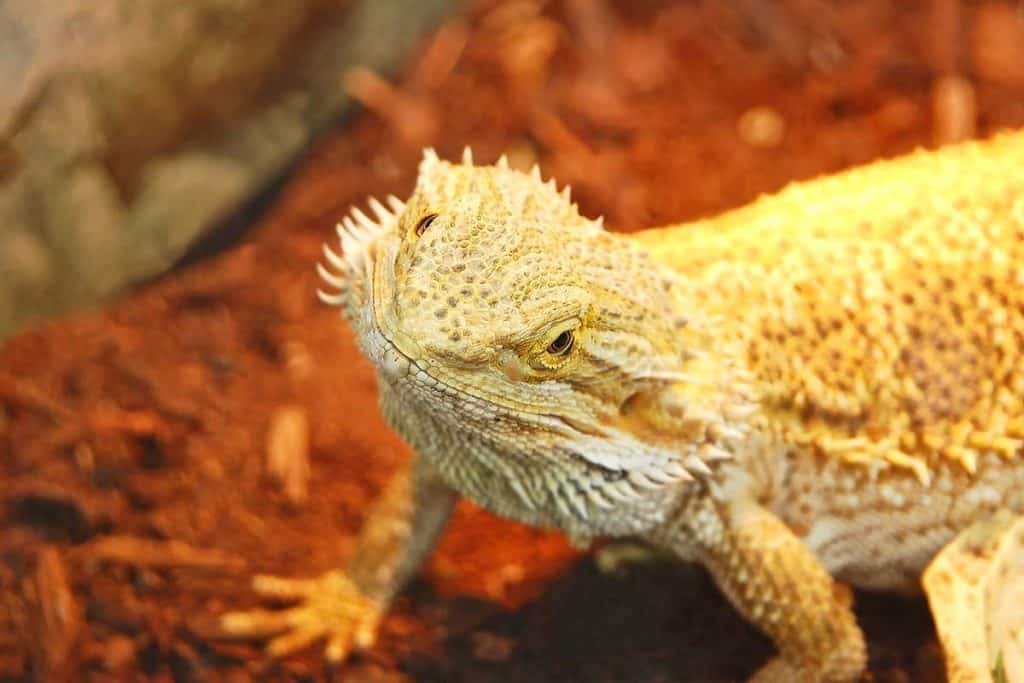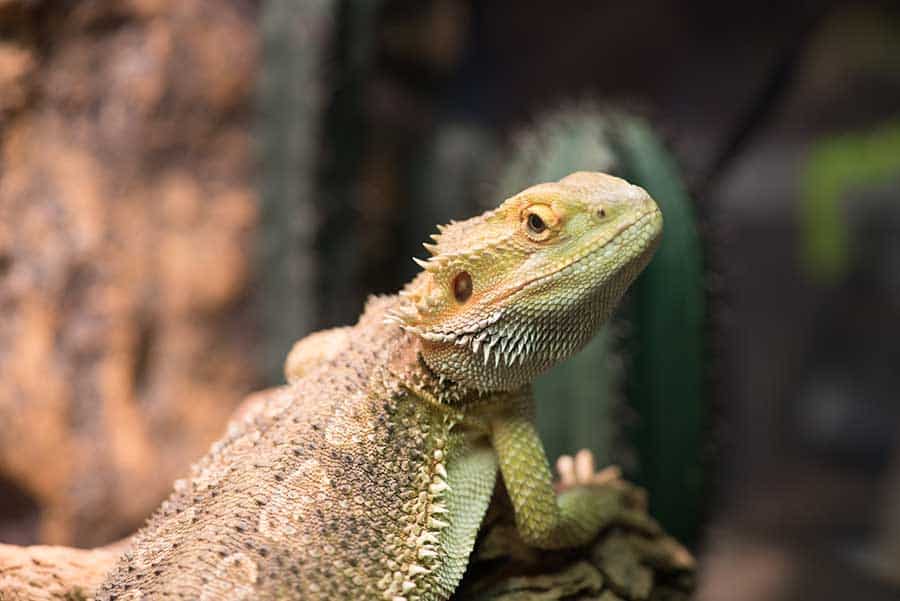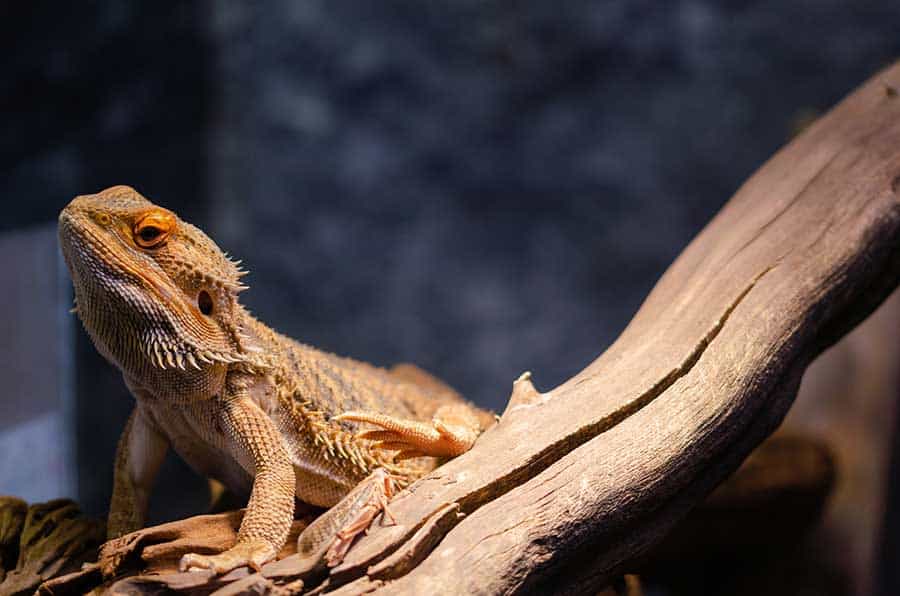Bearded dragon stress marks can alarm new owners because they can appear suddenly and make your bearded dragon look very ill. However, they are not always a sign that something is terribly wrong; they simply mean your beardie is just a little stressed.
Stress marks can form all over the bodies of both male and female bearded dragons. Stress marks are a darkening of the skin in splotches or stripes along the beard, neck, belly, and sides. Different bearded dragons will have different spots where their stress marks appear.
In conjunction with stress marks, your bearded dragon will experience other signs of stress, which you can identify quite easily.
Once you have identified that your beardie is definitely stressed out, you can start identifying why they are stressed and work on ways to avoid ‘manufactured’ stress in the future. Natural stress is unavoidable, but there are plenty of things you can do to help your beardie chill out!
Read on to find out how to identify stress, address the stressors, and keep a cool customer in the future!
What Bearded Dragon Stress Marks Look Like?
Bearded dragons are usually a tan to orange shade, with the exception of strongly colored morphs that can be white, black, red, or yellow! Bearded dragons also have natural light and dark markings on their bodies that help break up their outline in the wild.
Stress marks on a bearded dragon’s body will stand out against their coloring. They are large dark, almost black, splotches or stripes that will show up and disappear from time to time.
The stress marks will typically appear on their beards and the sides of their necks without their beards necessarily puffing up. The stress marks will also appear on their bellies and along their sides.
These marks can be distressing for you to see as their owner. However, do not worry too much, as there are things that you can do to eliminate stress from their lives! First, you will need to identify other signs of stress and what the potential stressors are, as this will tell you what level of stress your beardie is experiencing.
Other Signs of Stress in Bearded Dragons
There are many other signs of stress in bearded dragons aside from just stress marks. The key is to identify what is normal and what is strange for them. If the strange sign happens once or very rarely, then it was most likely nothing to worry about. However, if the strange sign persists or is repeated, then it is likely stress.
There are two different types of signs of stress your beardie can display: physical and mental, or behavioral.
Physical Signs of Stress
Stress can manifest in physical ways in bearded dragons apart from stress marks.
Beardies can suffer from constipation or diarrhea. This is a large cause of concern because it means they are not absorbing their nutrients correctly and will start becoming dehydrated.
Another physical sign of stress is constant or frequent shedding. Baby bearded dragons should shed fairly often, but adults should shed just once every month or two. For a more in-depth look at bearded dragon shedding, click here.
Behavioral Signs of Stress
Stress is largely indicated by behavioral changes in bearded dragons. Be on the lookout for repeated behavioral changes that are out of the norm for your bearded dragon.
Glass surfing is common in bearded dragons. This means your bearded dragon will run up to the enclosure wall and “skate” along it. There are a couple of reasons for glass surfing, but stress is often a large contributor. Here’s a closer look at glass surfing.
Inactivity is also a sign of stress. If your bearded dragon is no longer moving around and is staying hidden in one of their hides, they may very well be stressed out. There is a big problem with this behavior. as they cannot thermoregulate if they are staying in one place.
Avoiding food is another clear sign of stress. Your bearded dragon may not feel comfortable or safe enough to eat, which causes them additional stress. This may also be a sign that they have a high parasite load.
How Do I Treat Stress and Keep My Bearded Dragon Calm?
The main things that cause stress for bearded dragons can be found in their environment. This means that you will need to have a close look at their enclosure and routines to carefully identify where the stress is coming from and treat it.
Check Enclosure Settings Often
If the enclosure is too hot or too cold, then your bearded dragon will experience physical stress because it cannot thermoregulate properly. It is essential that you check your bearded dragon’s enclosure settings routinely to make sure they are functioning correctly.
Your bearded dragon’s enclosure should have a
If you see bearded dragon stress marks, make sure you first check their enclosure settings.
“I’m Pickin’ Up Good Vibrations”
Bearded dragons are very sensitive to sound and vibrations. Beardies may like music, but loud sounds cause big vibrations that hit the glass enclosure walls. Bearded dragons pick up on vibrations to understand the world around them.
Small vibrations mean they can detect prey close by, but bigger vibrations usually indicate the presence of predators. Therefore, if your bearded dragon is in a noisy area with a television, bass speakers, loud pets, children, or a lot of traffic noise, they will be bombarded with constant big vibrations, which they may interpret as danger.
If they are constantly being bombarded with these larger sounds and vibrations, then they will experience heightened and constant stress.
To combat this, place your bearded dragon’s enclosure in a quiet room away from the usual hustle and bustle of your house.
Keep the Enclosure Clean
Bearded dragons like to live in a clean environment. When their enclosures are dirty or have left over live prey running around, they will experience stress.
It is important to spot clean your bearded dragon’s enclosure daily and do a proper clean up once a week. For step-by-step instructions on how to clean your bearded dragon’s enclosure, check out this article.
All food needs to be cleared from the enclosure daily. If food items are left in the enclosure, then your bearded dragon can smell them starting to go bad, and this will cause them stress. If your bearded dragon eats food that has gone bad, then they will also suffer from intestinal distress.
Live prey, like crickets and roaches, can be difficult to keep track of when feeding your bearded dragon, especially when they are younger and the prey items are very small. If live prey is left in the enclosure, they will cause your bearded dragon stress by making noise and even biting your beardie while it is trying to sleep.
Bath Time
Not many people know this quirky fact, but most bearded dragons LOVE bath time. Bearded dragons enjoy being clean and having some time when they can soak and play around in water. If your bearded dragon does not get bathed, it can suffer from stress because they feel dirty.
Bathing your bearded dragon should be a routine thing that can happen every two to three days. It is not too difficult — here’s a step-by-step guide on bathing your bearded dragon.
Bath time is a soothing process where your bearded dragon has a chance to relax in some warm water. Being in the water will also help your bearded dragon poop if it is slightly constipated, which may also be causing stress marks to appear.
If your bearded dragon is shedding and they have stress marks, you can take them for an extra bath. This should calm them down to relieve stress and help their shedding along, too!
Cuddle Party!
Not all bearded dragons are the same, but most of them love a good pet and cuddle. Your bearded dragon may be experiencing anxiety and stress because they are separated from you. The simple fix for this is to cuddle and spend some one-on-one time with them!
If your bearded dragon is not one for person cuddles, then offer them a nice warm blankey to cuddle up in. The blanket will be warm and cozy like a hide but also soft on their skin which is soothing and calming.
I Need Some Alone Time!
However, on the flip side of this is too much cuddling or feeling like they are closed in and overstimulated by too many decorations.
If you are handling your bearded dragon for too long or too roughly and they start displaying stress marks, then it is time for them to go back to their enclosure and be left alone.
If your bearded dragon is not a cuddler and they are displaying stress marks and rushing around their enclosure, they may be feeling stifled by too many decorations. Open up some floor space for them to move around more freely.
Treats Work a Treat
When in doubt, reach for that treat! Sometimes, your bearded dragon just needs to feel a little extra love in their lives, and they often will want a treat from you. They may express this through displaying stress marks.
Give them a piece of juicy fruit that they love every now and then and see if this calms them down. Here are the fruits that are safe to give your bearded dragon.
FAQs on Stress in Bearded Dragons
When are stress marks normal on a bearded dragon?
Stress is a natural part of life, even for bearded dragons!
However, this natural stress should be purely physical when they are in captivity. The exception is baby and juvenile bearded dragons, as they will experience stress frequently because they are so much smaller than the world around them.
As they are moved to a different enclosure, they will be met with items such as hides, basking platforms, and water bowls that are much larger than what they are used to, and they may experience some heightened stress for a week or so.
Pregnant bearded dragon females will also often have stress marks on them, especially when they are close to laying their eggs, because pregnancy is physically taxing and causes stress on the body. Once they have laid their clutch of eggs, their stress marks should go away.
Finally, bearded dragons that are shedding may experience heightened levels of physical stress and will display stress marks toward the end of their shedding time. However, these marks should disappear within a day or two after they have completed their shed.
When should I worry about my bearded dragon’s stress marks?
Sometimes, stressed out bearded dragons need an urgent trip to the vet.
If the stress marks do not disappear within two weeks or are accompanied by other signs of illness such as impaction, bleeding or red and swollen gums, sunken eyes, open sores, or obvious distress, then taking them to the vet is the best decision.
In this case, your bearded dragon may be displaying stress marks because they are physically ill or in severe pain due to impaction, parasite overload, severe dehydration, metabolic bone disease, or infection.
At the Tail End of Things…
Stress marks on bearded dragons are stressful for pet owners, too. They look pretty alarming and are a clear indication that your bearded dragon is unhappy for some reason.
The first thing you should do is to check all of your bearded dragon’s enclosure settings to ensure they are correct and not causing physical stress such as heat stroke, being too cold, or dehydration.
Bearded dragons experience emotional stress, too! They can feel lonely if they are not handled enough, or they can be overwhelmed and overstimulated. They can even feel dirty because of an unclean enclosure or because they have not had a bath in a while.
Unless your bearded dragon has stress marks because it is physically ill, there are many things you can do to mitigate their stress and keep them calm.




